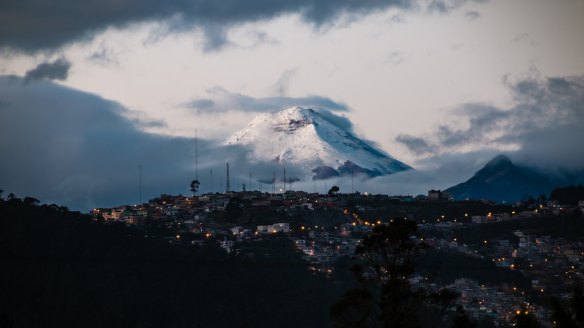
thank you Cesar Viteri for the photo
We took a few weeks off from the blog posts at TripTuner because we were doing some late summer traveling ourselves, but are now ready and raring to highlight more of the great destinations found on our site. Columbus Day is just a few weeks away, so now’s the time to start planning your trip. In honor of Columbus’ arrival to the new world, we thought we would highlight a destination in Latin America. This week’s locale is one of the most beautiful capital cities in the Spanish-speaking world: Quito, Ecuador.
Folded between green pleats of rolling hills and the Pinchincha volcano, Quito’s setting is spectacular. Terraced plots on the hillside are decorative mosaics above the shiny metropolis. The whitewashed buildings and colonial masterpieces of Old Town give way to expansive parks and modern edifices as you move up the valley. It really is quite staggering to find such natural beauty in a metropolis of about 2.5 million people.
My husband Bryan and I spent weeks on end in Quito while we were researching a guidebook on Ecuador. The town has it all – intriguing museums, excellent hotels, superior shopping opportunities, and unique colonial architecture. You might even find a Columbus Day (know in Ecuador as “Día de la Raza,” or “Day of the People”) parade while you’re there.
Here are some of my highlights of the city:
Old Town – Quito Antigua
There may be a higher concentration of colonial churches and religious art in Quito’s downtown than anywhere else in the world. That, and the fact that many of the buildings have been maintained in the colonial style, led UNESCO to name the entire area a World Heritage Site. I won’t go into detail about all there is to see downtown, but will simply call out some of my favorites. The tranquil Independence Plaza, with its spotless, manicured lawns, is a must-visit. Closed to traffic on two sides, it’s one of the mellower spots downtown. The soaring Gothic and Baroque-influenced Metropolitan Cathedral, one of the oldest in South America, sits on one edge of the plaza, while the Government Palace is on another. Also worth a visit is the San Francisco Monastery – take a look up to the choir area to notice the elaborate Moorish-style ceiling and large organ. The organ, capable of playing over 5000 notes, is only played once a year because the intricate wooden ceiling is made without nails or glue. Should one piece of wood be vibrated loose, the whole thing will fall.
The Hotels
Yes, I am calling out hotels as one of the highlights of the city. Quito has a wide variety of hotels housed in colonial buildings and decorated with impeccable style. Your immersion in the history of the city will literally take place while you sleep. The high-end Hotel Plaza Grande is located on the above-mentioned Independence Plaza in a building that dates from the 16th century. Picture rose petals on Frette linens, hand-carved wood, and impeccable service (Can I be there now please?). In the moderate price range you can’t do much better than the Mansion del Angel, where you will feel like you are stepping back over a century into the home of a Quito elite. Decorated with unique antiques, oriental carpets, intricate inlaid wooden floors, and original art works, La Mansion del Angel exudes elegance and style. Even in the less expensive category you can find gems like Hostal de La Rabida, a stylish 11-room inn located in an elegant home. Gracefully robed in whitewashed walls and stately French doors, the hostel includes a courtyard and luxuriant garden complete with resident rabbit.
Museums
Quito is has more than its fair share of history and church museums. One of my favorites is the San Francisco Museum attached to the like-named monastery where you can learn about the Quito school of art and its most famous painter Miguel de Santiago. Born to lower-class parents in the 1620s, Santiago became renowned for his mastery of ambitious compositions and unified structures. His paintings were in such high demand in the 17th century that many were sent to the Vatican. Santiago painted directly onto blank canvases — if he didn’t like the position of a limb, he would just paint over it. You see evidence of this in the museum, where pigment has fallen off over the centuries to reveal figures with two heads or three legs.
Another excellent option is the small Guayasimin Museum located in the northern neighborhood of Bellavista. Guayasim started the indigenismo artist movement in Ecuador, which portrays the harsh realities of the country’s poor and marginalized indigenous peoples. The museum is located in his house, so you get a feel for both and man and his works.
Shopping
Artisanal handicrafts of amazing breadth and depth are created throughout Ecuador by its indigenous cultures. Find singular items from around the country at boutiques like Folklore Olga Fisch or Galeria Latina. For high quality jewelry with an Ecuadorian flair, Ag Joyería is the place to go.
Whether you want to explore the history of colonial Latin America, learn about a modern artistic movement, or give your MasterCard a workout, Quito is the city for you this Columbus Day. Just #tune it!
